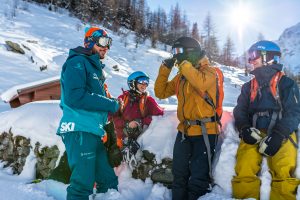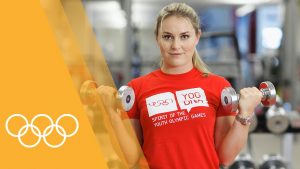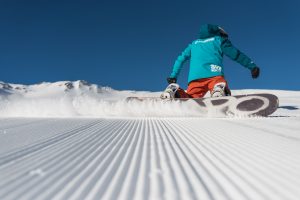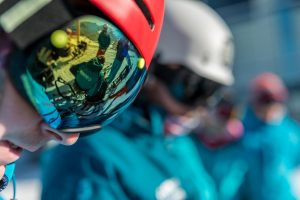If you haven’t been there, it’s pretty likely you’ll know someone who has. With thousands of people reportedly admitted to in-resort doctor’s surgeries, walk-in clinics and A&Es every season, we’ve enlisted the help of surgeon Simon Moyes and Oxygène ski instructor, Jenny Gardiner, to keep us away from the emergency room and happy on the slopes this winter.
So, to ensure that your safety is no accident, here’s their 7 top tips on how to avoid ski injuries this season.
LEARN FROM THE EXPERTS
“If you are not an experienced skier, then enrolling in an appropriate ski school such as Oxygène is a sensible option”, says Mr Moyes.
Skiing and snowboarding aren’t considered extreme sports for nothing. ‘Extreme’ suggests ‘danger’ and danger certainly isn’t risk-free. In our experience, it’s all about respecting your sport or discipline. And one way to do just that is to invest in lessons from specially-trained ski experts and reap the benefits of insider-knowledge tailored exactly to your ski needs.
According to Mr Moyes, the most common cause of ski-related injuries is attributed to the incorrect set-up of equipment.
“All too often people find themselves in my practice because of poorly-adjusted bindings that fail to consider the client’s height, weight and ski level. If the bindings are adjusted to a setting that lies outside of the clients’ specifications, there is a higher risk of them failing to release the boot from the skis, and subsequently, a greater threat of injury. It is therefore important that the bindings are fitted by someone qualified to do so, hence why we recommend learning from the experts.”
Likewise, ski poles are the other well-known culprits reportedly responsible for tearing the ulnar collateral ligament of the thumb; one of the most common ski injuries. To avoid landing awkwardly on them and thus prevent injury, skiers are advised to use their poles without the wrist-straps so they can drop them as soon as they realise they are falling.
To find your expert, and for more information on lessons, availability and bookings, visit Oxygène’s website.
WARM UP
It’s difficult to stress the importance of stretching and preparing your muscles before heading to the slopes. Just as with any other type of sport or exercise, the warm up is imperative for ensuring optimum performance and preventing injuries.
“Always start from the top down”, explains Jenny. “Concentrate first on loosening and awakening the muscles in your neck and head. Left to right, then up and down and so on.”
Remember to keep the movements fluid and controlled. Avoid any sudden, sharp gestures and pay attention to your breathing.”
“Now it’s time to move on to your shoulders and arms. Start by gently rotating your shoulder cuffs and extend the stretch by incorporating your arms one by one. Draw one arm across your chest and use the other to deepen the stretch by pulling gently on the elbow.”
Once your upper body is warm, it’s time to move on to your back, hips, legs and ankles. If you’re not sure, speak to your instructor or check out one of the many great warm-up videos on YouTube.”
Apparently, a mere 5-to-10-minute warm-up is all it takes to prepare your limbs for skiing success.
“You don’t need to spend hours stretching and warming up”, continues Jenny. “30 seconds of star jumps, running on the spot or even jumping up and down is typically all it takes to get your heart rate pumping and from there a 5-to-10-minute full-body stretch will suffice.”
Seemingly, the key is finding a way to incorporate this into your daily routine.
“Aim to warm-up at the same time of day, say after the shower or before breakfast, and try to vary the stretches by listening to your body and muscles.”
Psst: Keep things fresh and discover new routines by checking out Lindsey Vonn’s Ski Warm Up Techniques, courtesy of the Olympic Channel.
PROTECT YOURSELF
As it infers from the name, safety protection – including helmets, back protectors, impact shorts, wrist and knee guards – offers added security in the form of cushioning and responsive pads for ski and snowboarders’ most vulnerable body parts while on the slopes.
Ranging in price from £40 – £400, it’s fair to surmise that both the quality and variety of impact body armour and safety protection has improved tenfold in the last decade alone.
“It’s encouraging to see that more and more skiers and snowboarders are wearing added protection on the slopes”, says Jenny. “Although they do not prevent injury as such, they can decrease the amount of stress and severity of the more minor falls. I always advise my clients to – at the very least – wear a helmet, and to only go off-piste if equipped with the correct safety equipment (including arvas, snow probes, ABS, transceiver etc.)”.
Despite the obvious advantages of extra padding for those problem-areas, some professionals fear this can lead to overconfidence and therefore an increased temptation to ski irresponsibly. Even when it comes to now-almost-essential items such as helmets, which have revealed an impressive 30% to 50% decrease in in-resort head-injury statistics over recent years, experts continue to urge skiers to always ski and ride in control.
Psst: Check out Blue Tomato’s selection of body armour, ski protection and helmets.
ASK THE PISTEURS
Et chez vous, ça se passe comment le PIDA?Ici, à la Rosière
Publié par ANPSP – Pisteurs secouristes sans frontière sur mercredi 16 mars 2016
If you don’t ask you don’t get. That’s Jenny’s top advice for staying ski-injury-free this winter.
“Some people are either too proud or embarrassed to ask for advice on the slopes. Whether you plan to venture on or off-piste, it’s always a good idea to have a little chat with the Pisteurs/ Ski Patrol, who are normally found at each lift station”, says Jenny. “With access to the most up-to-date weather and piste information, they are only too happy to help by answering your questions and their tips are typically indispensable.”
As the guardians of the slopes – whose responsibilities include opening and closing the lifts as well as monitoring snow conditions each day – their knowledge and experience is not only unparalleled, but also invaluable.”
So, the next time you’re on the mountain (and especially if you want to go off-piste), why not make it a mandatory mission among your group to ask the Pisteurs for their opinion on the safest-spots to shred?
Psst: Stay ultra-safe and explain your ski day plans to the Pisteurs, including any couloirs or off-piste terrain.
Discover the pisteurs’ missions in this video, courtesy of La Rosière’s pisteurs.
AVOID COLLISIONS
According to a 2016 NSSA report, over 6% of ski-related injuries are caused by collisions with another person on the slopes each year.
Dr Moyes explains: “The next most common cause of injuries in my experience is collisions, typically between skiers and snowboarders who have different fall lines. Thus, to minimise the risk of collision, it’s best to ensure you remain aware of not only your surroundings, but also the position of other skiers and snowboarders too.”
“Remember skiers and snowboarders don’t see the slopes the same way”, adds Jenny. “For example, snowboarders can’t see behind their backs and typically need to keep speed once they’ve picked their line on a mellow cat track or piste – as skiers we don’t always think about that.”
“To prevent and avoid collisions, slow down well in advance before you enter a lift queue.”
Psst: Remember to abide by ‘the laws’ of the piste:
- Stay in control.
- Stop in a safe, clear place on the side of the piste.
- When starting downhill or merging, look uphill and wait if necessary.
- Read and obey the signs for slow zones and intersecting areas.
- Share the slopes and always show respect for others.
STAY HUMBLE
It is fair to assume that we have all, at some point, been tempted out of our depths and far beyond our skiing or snowboarding capabilities. Perhaps you were out for the day with a new group whose expertise and experience extended past your limits? Or, maybe you met some old friends on the mountain for lunch and the ski down was more Bambi-on-ice than Ski Sunday? Whatever the reason, Mr Moyes and Jenny suggest forgetting your pride and staying humble on the pistes:
- Mr Moyes: “Ski within the limits of your own expertise, i.e. only ski those slopes and runs that you are experienced enough to do so. A lot of these runs will be condition dependent; while some pistes in good visibility with a large covering of snow are easy to ski on, zero visibility or whiteout conditions as well as ice can become quite hazardous. Choose your routes carefully, look at the piste map for unfamiliar areas and try to ensure that the conditions are appropriate for your level of skiing expertise.”
- Jenny: “For most advanced riders, skiing with beginners on the slopes can be quite annoying. That’s why I urge my more confident students to remember that they were a beginner once as well. So, when you see an instructor linking turns, followed by 8 or 10 kids – be careful. Bear in mind that if you get in their way, they’ll keep their trajectory. Yes, kids may be more predictable but equally, they’re also more delicate.
STAY INSURED
Finally, watch out for the small print on your ski insurance policy. Unlike what many believe, most extreme-sport/ ski insurance brokers only cover treatment for injuries sustained on the slopes while you are abroad and continue to receive treatment in that same country.
“More often than not, I hear from patients whose insurance becomes null and void once they’ve returned to the UK”, comments Mr Moyes. “Considering that rehabilitation programmes are typically required for the majority of ski-related injuries – including regular physiotherapy appointments, check-ups and consultations, which can last months or sometimes even years – it’s surprising to see how many people find themselves in this situation.”
“Therefore, my last piece of advice is to carefully check your insurance policy before signing up.”
For more information, please visit Mr Moyes’ website.
Mr Moyes
Mr Simon Moyes is a keen skier and leading Orthopaedic surgeon specialising in arthroscopic and minimally invasive treatment of problems of the knee, shoulder, foot and ankle with a focus on Sports Medicine. He practices privately out of The Wellington Hospital, St. John and Elizabeth’s Hospital, and city based, 31 Old Broad Street (part of London Bridge Hospital). Here he offers the inexperienced skier advice on how to deal with injuries.
Jenny Gardiner
Originally from Wales, Jenny always wanted to learn to ski and became a ski instructor at the age of 18. Being a passionate rider herself, she enjoys sharing tips with skiers and snowboarders and see them progress. She lives in Aime-La Plagne with her husband and children and after 18 years with Oxygène, she now heads Oxygène ski instructor program – training young instructors to become fully qualified.





